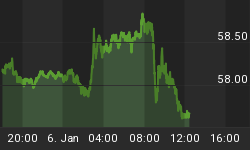Fed Chairman Bernanke's testimony sounded off a message largely similar to the June 29 FOMC statement by echoing a less ambiguous outlook on a moderating economic activity, while maintaining vigilance against inflation.
BOTTOM LINE: The Fed faces the existing threat of rising inflation and the gradually approaching threat of a slowing economy. Since the more urgent threat is underlined by actual inflation rather than slowing growth, the Fed will have to (and likely) deliver the appropriate policy measure to tackle the more pressing threat by raising the fed funds rates to 5.50% next month.
Raising interest rates 17 times and pausing in August in the face of rising inflation and $77-$80 oil is akin to taking a long journey by foot to a train station without eventually taking getting on the train. Making a pause in August, followed by renewed hike in fall would not only trigger fresh questions on the credibility and competency of the Fed, but also would make an additional rate hike less welcoming by the financial markets than in the scenario of an August rate hike.

We view the FX market reaction of shedding more than a cent off the dollar against the European currencies and a full yen against the Japanese currency as an overreaction. FX and bond markets largely focused on Bernanke's stating the obvious, namely: "The FOMC projections... anticipate slightly lower growth in real output", which may imply that the Fed is near the end.
But the testimony shows no signs of deprioritizing inflation. The Fed raised its core PCE price index projection for the rest of the year to 2.25%-2.50% from February's 1.75%-2.00%. Bearing in mind that Bernanke's testimony does reflect this morning's 4th consecutive monthly 0.3% reading in core CPI -- the highest year- on -year core CPI reading since January 2002, the Chairman is apt to keep the door open for an August 25-bp rate hike, which we expect to be pursued.
Indeed, the testimony devoted more ink to moderating growth and the likelihood of further cooling when stating the:" the lags between policy actions and their effects". But the recent slowing in US data does not suggest an urgency of economic contraction, as the existing urgency of rising oil prices and inflation is currently embedded in the latest data. In fact, the retreat in the June headline CPI to 0.2% from 0.4% in May and the unchanged 0.3% in the core figure reflected a 0.9% decline in energy prices in June following a 2.4% increase in May. It is possible that by August 8th, the Fed would have made its own preliminary estimates for the July CPI, which will be largely a function of oil prices in the remainder of the month.
June FOMC Minutes may be past info but revealing and relevant. Thursday's release of the minutes from the June FOMC meeting may bear less significance following today's more current testimony. Nevertheless, we expect the market greater attention to these minutes as they supply us with a wider range regarding the breadth of policymakers' thinking, rather than Bernanke's more central delivery, whose media exposure limits it from shedding the level of detail that can be found in the minutes.
FX Outlook
The Fed's projections for lower GDP growth in the second half of the year and for lower core PCE price index next year (following a possible run-up in the second half of the current year) should start weighing on the US dollar by offsetting the risk of uncertainty for an August hike. Aside from the Treasury-bound safe haven flows helping the greenback, the dollar shall remain with a favorable cost of carry that could make medium term carry trades a risky enterprise. In addition, there has been no real correlation between slowing US economy and a falling dollar.
Instead, the more pressing sources of dollar downside emerge from not only rising chances of an August pause, but also the extent to which markets believe that an August rate hike would be the last. This latter point could especially emerge if next week's release of home sales figures (existing and new) finally show a unanimous decline, and a tepid July payrolls report is accompanied by a retreat in the average hourly earnings. Equally important, is the August 1st release of the June core PCE price index and whether it will post 2.1% for the third straight month.
As for the market message, despite the continued 5-6 bp yield inversion in favor of 2-year yields over 10-year yields, the 10-year yield remains 20 bps below the fed funds rate, suggesting that any further rate hikes may be untenable.
The markets' forward looking emphasis on moderating growth and post-August Fed is likely to more than offset any positive dollar dynamics that may occur from continued escalation in the Mideast. We expect the euro to carry upward support at the 1.25 figure, with preliminary target at 1.2750 by month-end. We expect USDJPY to retreat towards its 200 day MA of 116, with support building up at 115.25-30 by month-end. Only an actual outright yuan revaluation by the PBOC (odds at 50% in Q3) would breach the 115 and onto 114.50.
















